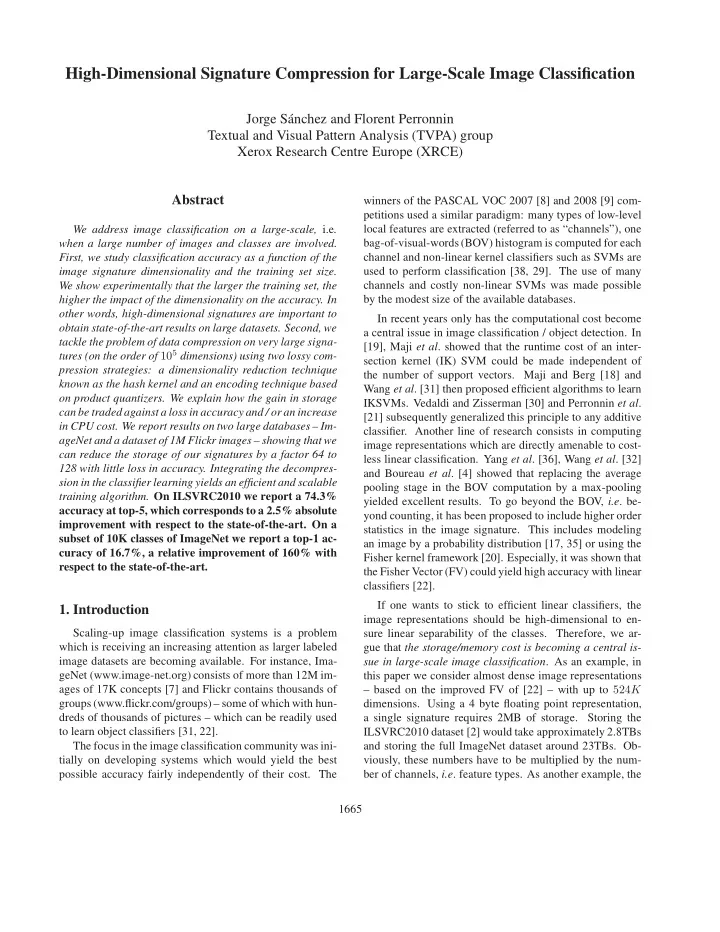

High-Dimensional Signature Compression for Large-Scale Image Classification Jorge S´ anchez and Florent Perronnin Textual and Visual Pattern Analysis (TVPA) group Xerox Research Centre Europe (XRCE) Abstract winners of the PASCAL VOC 2007 [8] and 2008 [9] com- petitions used a similar paradigm: many types of low-level local features are extracted (referred to as “channels”), one We address image classification on a large-scale, i.e . bag-of-visual-words (BOV) histogram is computed for each when a large number of images and classes are involved. channel and non-linear kernel classifiers such as SVMs are First, we study classification accuracy as a function of the image signature dimensionality and the training set size. used to perform classification [38, 29]. The use of many We show experimentally that the larger the training set, the channels and costly non-linear SVMs was made possible higher the impact of the dimensionality on the accuracy. In by the modest size of the available databases. other words, high-dimensional signatures are important to In recent years only has the computational cost become obtain state-of-the-art results on large datasets. Second, we a central issue in image classification / object detection. In tackle the problem of data compression on very large signa- [19], Maji et al . showed that the runtime cost of an inter- tures (on the order of 10 5 dimensions) using two lossy com- section kernel (IK) SVM could be made independent of pression strategies: a dimensionality reduction technique the number of support vectors. Maji and Berg [18] and known as the hash kernel and an encoding technique based Wang et al . [31] then proposed efficient algorithms to learn on product quantizers. We explain how the gain in storage IKSVMs. Vedaldi and Zisserman [30] and Perronnin et al . can be traded against a loss in accuracy and / or an increase [21] subsequently generalized this principle to any additive in CPU cost. We report results on two large databases – Im- classifier. Another line of research consists in computing ageNet and a dataset of 1M Flickr images – showing that we image representations which are directly amenable to cost- can reduce the storage of our signatures by a factor 64 to less linear classification. Yang et al . [36], Wang et al . [32] 128 with little loss in accuracy. Integrating the decompres- and Boureau et al . [4] showed that replacing the average sion in the classifier learning yields an efficient and scalable pooling stage in the BOV computation by a max-pooling training algorithm. On ILSVRC2010 we report a 74.3% yielded excellent results. To go beyond the BOV, i.e . be- accuracy at top-5, which corresponds to a 2.5% absolute yond counting, it has been proposed to include higher order improvement with respect to the state-of-the-art. On a statistics in the image signature. This includes modeling subset of 10K classes of ImageNet we report a top-1 ac- an image by a probability distribution [17, 35] or using the curacy of 16.7%, a relative improvement of 160% with Fisher kernel framework [20]. Especially, it was shown that respect to the state-of-the-art. the Fisher Vector (FV) could yield high accuracy with linear classifiers [22]. If one wants to stick to efficient linear classifiers, the 1. Introduction image representations should be high-dimensional to en- Scaling-up image classification systems is a problem sure linear separability of the classes. Therefore, we ar- which is receiving an increasing attention as larger labeled gue that the storage/memory cost is becoming a central is- image datasets are becoming available. For instance, Ima- sue in large-scale image classification . As an example, in geNet (www.image-net.org) consists of more than 12M im- this paper we consider almost dense image representations – based on the improved FV of [22] – with up to 524 K ages of 17K concepts [7] and Flickr contains thousands of groups (www.flickr.com/groups)– some of which with hun- dimensions. Using a 4 byte floating point representation, dreds of thousands of pictures – which can be readily used a single signature requires 2MB of storage. Storing the to learn object classifiers [31, 22]. ILSVRC2010 dataset [2] would take approximately 2.8TBs The focus in the image classification community was ini- and storing the full ImageNet dataset around 23TBs. Ob- tially on developing systems which would yield the best viously, these numbers have to be multiplied by the num- possible accuracy fairly independently of their cost. The ber of channels, i.e . feature types. As another example, the 1665
Recommend
More recommend